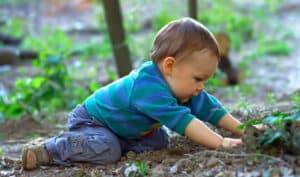
“It’s our polite nudge in the ribs to help you and your team stay organised and on task.”
This week’s subject is: Natural elements.
Element 3.2.3: The service cares for the environment and supports children to become environmentally responsible
Does your service provide a range of natural resources to support children’s learning and promote awareness about sustainability?
Educators encourage children and young people to develop appreciation of the natural world, understand our impact on the natural world, and the interdependence between people, animals, plants, lands and waters. (Early Years Learning Framework; Framework for School Age Care).
Where possible, services should seek out resources that are made of natural fibres rather than plastics and other synthetic materials. Providing children with natural materials in the learning environment has many benefits:
-
- Promotes sustainability; Natural fibers such as cotton, wool, bamboo, and hemp are renewable resources that can be grown and harvested sustainably, reducing the environmental impact compared to synthetic materials
- Promotes environmental awareness; Using natural fiber resources provides an opportunity to teach children about sustainability, renewable resources, and the environmental impact of different materials. Educators should remember to use teachable moments to ask questions that spark interest and activate young minds
- Supports sensory stimulation; Natural fiber resources tend to be softer and more comfortable than synthetic materials, providing a more pleasant sensory experience for children which supports them to explore, problem solve and be creative in their play
- Biodegradability; Natural fiber resources are biodegradable, therefore they break down naturally over time, reducing the amount of waste generated by the Service
- Supports connection to nature; Natural fiber resources help children develop a connection to the natural world by using materials that come from plants and animals
Natural elements that have been extracted from the natural environment must be safe and age appropriate. Ensure that the materials selected do not pose any risk to children i.e. chocking hazards and sharp objects and ensure children regularly wash their hands.
A wide range of natural elements can be incorporated into the educational program for both indoor and outdoor, structured and non-structured experiences. Involve children in the collection of natural materials, encourage questioning and discussion about what’s being collected and the range of possibilities for their use to spark curiosity and support children’s evolving environmental awareness.
Natural elements to incorporate in the indoor and outdoor learning environments:
-
- Sand, dirt and mud
- Twigs, sticks and branches of different sizes, shapes and colours
- A variety of flowers of differing sizes, shapes, clolours and scents
- Seashells of varying shapes and colours
- A variety of different coloured leaves
- Different coloured/shades of bark
- A variety of pebbles and stones with varying textures, colours, shapes and sizes
- Grass of varying shades
- Selection of pinecones in varying shapes, textures and sizes
Promote the use of natural elements with families by showcasing children’s creations and sharing learning stories about planned and unplanned experiences involving natural elements. Provide families with information and resources to encourage outdoor play and exploration of the natural environment at home and outside of the Service.
Resources for families:
10 things to do to have fun in the backyard
10 ways to nature play from a balcony
Nature play ideas and activities in your backyard
Resources for Services:
ECA Learning Hub- Natural play in your environment, Embedding sustainable practices
Environmental Education in Early Childhood
Early Learning Nature Play Experiences (for infants and toddlers)
Learning and playing with: Sticks, Dirt, Leaves, Pebbles
Within System7 go to Quality Area 3/Module 11 submit self-assessment notes and if required, open a QIP issue if you identify any areas of improvement.
The Childcare Centre Desktop has a range of resources to assist services with being environmental responsible. These include Sustainability Commitment Statement, Sustainability Audit, Outdoor Environment and Playground Safety Audit, Environmentally Responsible Policy, Environmental and Sustainability Officer Position Description and much more.
Resources, NQS Element, Regulation and System7 links
Childcare Centre Desktop – Childcare Centre Desktop
National Quality Standard – QA 3/ 3.2.3- Environmentally responsible
National Regulations – 73, 110
System7 Module – QA 3/ Module 11
If you have any questions send us a note via the Contact page here!




